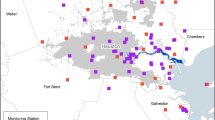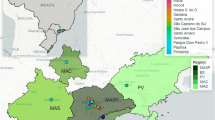Abstract
The objective of the present work is to compare various techniques for modeling the dependence of the tropospheric ozone concentrations on several meteorological and pollutant parameters. The study focuses on two different sites in the metropolitan area of Athens, Greece; one in the city centre and another one in the suburbs. It is found that although simple Linear Regression Analysis fails to construct accurate equations due to the existence of multicollinearity among the independent variables, still various combinations of a Multivariate Method (PCA) and Stepwise Regression Analysis manage to produce equations free of the multicollinearity issue. The derived formulas are validated and prove to have R 2 values in the order of 0.8 approximately. However, the equations are found to be unsuccessful in case of severe episodes. For this reason, a new procedure is followed for estimating the ozone values in case of episodes exclusively. The new R 2 value is estimated to be 0.9, approximately.
Similar content being viewed by others
References
Abdul-Wahab, S. A., Bakheit, C. S., & Al-Alawi, S. M. (2005). Principal Component and multiple regression analysis in modelling of ground-level ozone and factors affecting its concentrations. Environmental Modelling & Software, 20, 1263–1271.
Agirre-Basurko, E., Ibarra-Berastegi, G., & Madariaga, I. (2006). Regression and multilayer perception-based models to forecast hourly O3 and NO2 levels in the Bilbao area. Environmental Modelling & Software, 21(4), 430–446.
Ambroise, C., & Grandvalet, Y. (2001). Prediction of ozone peaks by mixture models. Ecological Modelling, 145, 275–289.
Asimakopoulos, D., Helmis, C. G., Papadopoulos, K. H., Kalogiros, J. A., Kassomenos, P., & Petrakis, M. (1999). Inland propagation of sea breeze under opposing offshore winds. Meteorology and Atmospheric Physics, 70, 97–110.
Balaguer Ballester, E., Camps i Valls, G., Carrasco-Rodriguez, J. L., Soria Olivas, E., & Del Valle-Tascon, S. (2002). Effective 1-day ahead prediction of hourly surface ozone concentrations in eastern Spain using linear models and neural networks. Ecological Modelling, 156, 27–41.
Bartzokas, A., & Metaxas, D. A. (1995). Factor Analysis of some climatological elements in Athens, 1931–1992: Covariability and Climatic Change. Theoretical and Applied Climatology, 52, 195–205.
Bartzokas, A., Paliatsos, G. A., & Ziomas, I. C. (1997). Variability and covariability of basic air pollutants in Athens. Fresenius Environmental Bulletin, 6, 178–183.
Brauer, M., & Brook, J. R. (1997). Ozone personal exposures and health effects for selected groups residing in the Fraser Valley. Atmospheric Environment, 31, 2113–2121.
Burnett, R. T., Brook, J. R., Yung, W. T., Dales, R. E., & Krewski, D. (1997). Association between ozone and hospitalization for respiratory diseases in 16 Canadian cities. Environmental Research, 72, 24–31.
Chaloulakou, A., Saisana, M., & Spyrellis, N. (2003). Comparative assessment of neural networks and regression models for forecasting summertime ozone in Athens. The Science of the Total Environment, 313, 1–13.
Flaum, J. B., Rao, S. T., & Zubenko, L. G. (1996). Moderating the influence of meteorological conditions on ambient ozone concentrations. Journal of the Air and Waste Management Association, 46, 35–46.
European Parliament and the Council (2002). Guidance for implementing directive related to ozone in ambient air 2002/3/EC.
Helmis, C. G., Asimakopoulos, D. N., Papadopoulos, K. H., Kassomenos, P., Kalogiros, J. A., Papageorgas, P. G., et al. (1997). Air mass exchange between the Athens Basin and the Messogia Plain of Attica, Greece. Atmospheric Environment, 31, 3833–3849.
Jolliffe, I. T. (1986). Principal component analysis (p. 271). New York: Springer.
Kallos, G., Kassomenos, P., & Pielke, R. A. (1993). Synoptic and mesoscale weather conditions during air pollution episodes in Athens, Greece. Boundary Layer Meteorology, 62, 163–184.
Kallos, G., Papadopoulos, A., Varinou, M., & Kassomenos, P. (1995). Estimation of the contribution to air quality degradation in Athens from major elevated sources. International Journal of Environment and Pollution, 5, 611–622.
Kambezidis, H., Kassomenos, P., & Kiriaki, H. (1986). Smoke concentration levels in a monitoring network in Athens, Greece. Atmospheric Environment, 20, 601–604.
Kassomenos, P. A., & Koletsis, I. G. (2005). Seasonal variation of the temperature inversions over Athens, Greece. International Journal of Climatology, 25(12), 1651–1663.
Kassomenos, P., Lykoudis, S., & Petrakis, M. (1997). On the behaviour of air pollutants released from elevated stacks in the vicinity of Athens, Greece. International Journal of Environment and Pollution, 8, 134–147.
Kassomenos, P., Petrakis, M., Lykoudis, S., & Papadopoulos, A. (1996). Mesoscale transport of air pollutants over Athens: Implications for air quality. International Journal of Environment and Pollution, 6, 214–224.
Kassomenos, P., Skouloudis, A. N., Lykoudis, H. S., & Flocas, H. A. (1999). “Air Quality Indicators” for Uniform Indexing of Atmospheric Pollution in Large Metropolitan Areas. Atmospheric Environment, 33, 1861–1879.
Katsoulis, B., & Kassomenos, P. (2004). Assessment of the air-quality over Urban areas by means of biometeorological indices, The case of Athens, Greece. Environmental Technology, 25, 1293–1304.
Melas, D., Kioutsioukis, I., & Ziomas, I. (2000). Neural network model for predicting peak photochemical pollutant levels. Journal of the Air and Waste Management Association, 50, 495–501.
Paschalidou, A. K., & Kassomenos, P. A. (2004). Comparison of air pollutant concentrations between weekdays and weekends in Athens, Greece for various meteorological conditions. Environmental Technology, 25, 1241–1255.
Pilinis, C., Kassomenos, P., & Kallos, G. (1993). Modelling of photochemical pollution in Athens, Greece: Application of the RAMS-CALGRID modelling system. Atmospheric Environment, 27B, 353–370.
Sindosi, O. A., Katsoulis, B. D., & Bartzokas, A. (2003). An objective definition of air mass types affecting Athens, Greece; the corresponding atmospheric pressure patterns and air pollution levels. Environmental Technology, 24, 947–962.
Smith-Doron, M., Stieb, D., Raizenne, M., Brook, J., Dales, R., Leech, J., et al. (2000). Association between ozone and hospitalisation for acute respiratory diseases in children less than 2 years of age. American Journal of Epidemiology, 153, 444–452.
Soja, G., & Soja, A. M. (1999). Ozone indices based on simple meteorological parameters: potential and limitations of regression and neural network models. Atmospheric Environment, 33, 4229–4307.
Sousa, S. I. V., Martins, F. G., Alvim-Ferraz, M. C. M., & Pereira, M. C. (2007). Multiple linear regression and artificial neural networks based on principal components to predict ozone concentrations. Environmental Modelling & Software, 22(1), 97–103.
SPSS Base 7.5 for Windows (1997). User’s guide, SPSS Inc, ISBN 0-13-657214-6, Chicago IL, USA, 628 pp.
Statheropoulos, M., Vassiliadis, N., & Pappa, A. (1998). Principal component and canonical correlation analysis for examining air pollution and meteorological data. Atmospheric Environment, 32, 1087–1095.
Thompson, M. L., Reynolds, J., Cox, L. H., Guttorp, P., & Sampson, P. D. (2001). A review on statistical methods for the meteorological adjustment of tropospheric ozone. Atmospheric Environment, 35, 617–630.
Vukovich, F. M., & Sherwell, J. (2003). An examination of the relationship between certain meteorological parameters and surface ozone variations in the Baltimore—Washington corridor. Atmospheric Environment, 37, 971–981.
Wilks, D. S. (1995). Statistical methods in the atmospheric sciences. An Introduction. International Geophysics Series, v.59, San Diego, p. 467.
Wise, E. K., & Comrie, A. C. (2005). Meteorologically adjusted urban air quality trends in the Southwestern United States. Atmospheric Environment, 39, 2969–2980.
Yi, J., & Pybutok, R. (1996). A neural network model forecasting for prediction of daily maximum ozone concentrations in an industrialized urban area. Environmental Pollution, 92, 349–357.
Author information
Authors and Affiliations
Corresponding author
Rights and permissions
About this article
Cite this article
Paschalidou, A.K., Kassomenos, P.A. & Bartzokas, A. A comparative study on various statistical techniques predicting ozone concentrations: implications to environmental management. Environ Monit Assess 148, 277–289 (2009). https://doi.org/10.1007/s10661-008-0158-0
Received:
Accepted:
Published:
Issue Date:
DOI: https://doi.org/10.1007/s10661-008-0158-0




